class: middle center # Early Prediction of COVID Surge ## An Exercise in Exploratory Data Analysis ### Deepayan Sarkar ### _Indian Statistical Institute_ <h1 onclick="document.documentElement.requestFullscreen();" style="cursor: pointer;"> <svg xmlns="http://www.w3.org/2000/svg" width="16" height="16" fill="currentColor" class="bi bi-arrows-fullscreen" viewBox="0 0 16 16"> <path fill-rule="evenodd" d="M5.828 10.172a.5.5 0 0 0-.707 0l-4.096 4.096V11.5a.5.5 0 0 0-1 0v3.975a.5.5 0 0 0 .5.5H4.5a.5.5 0 0 0 0-1H1.732l4.096-4.096a.5.5 0 0 0 0-.707zm4.344 0a.5.5 0 0 1 .707 0l4.096 4.096V11.5a.5.5 0 1 1 1 0v3.975a.5.5 0 0 1-.5.5H11.5a.5.5 0 0 1 0-1h2.768l-4.096-4.096a.5.5 0 0 1 0-.707zm0-4.344a.5.5 0 0 0 .707 0l4.096-4.096V4.5a.5.5 0 1 0 1 0V.525a.5.5 0 0 0-.5-.5H11.5a.5.5 0 0 0 0 1h2.768l-4.096 4.096a.5.5 0 0 0 0 .707zm-4.344 0a.5.5 0 0 1-.707 0L1.025 1.732V4.5a.5.5 0 0 1-1 0V.525a.5.5 0 0 1 .5-.5H4.5a.5.5 0 0 1 0 1H1.732l4.096 4.096a.5.5 0 0 1 0 .707z"/> </svg> </h1> --- # Disclaimer - This talk has very little "statistics" (in the conventional sense) - The data analysis is based mostly on very simple ideas and models - The emphasis of this talk is more on the _process_ than the outcome -- - Also, it's important to remember that .center[ .emph[ All models are wrong ] ( but some are useful ) — George Box ] --- # Outline - What do we want to predict and why? - Are we able to predict the past? - How did we arrive at our method? - Joint work with Siva Athreya and Rajesh Sundaresan <div> $$ \newcommand{\sub}{_} \newcommand{\confirmed}[1]{x(#1)} \newcommand{\active}[1]{a(#1)} \newcommand{\dactive}[1]{a^{\prime}(#1)} \newcommand{\dconfirmed}[1]{x^{\prime}(#1)} \newcommand{\ractive}[1]{\lambda(#1)} \newcommand{\ractivehat}[1]{\hat{\lambda}(#1)} \newcommand{\rconfirmed}[1]{\gamma(#1)} \newcommand{\rincrement}[1]{\rho(#1)} \newcommand{\rincrementhat}[1]{\hat{\rho}(#1)} \newcommand{\rinactive}[1]{\mu(#1)} $$ </div> .center[ [ Updated: 2022-02-16 ] ] --- class: middle center # What do we want to predict? --- 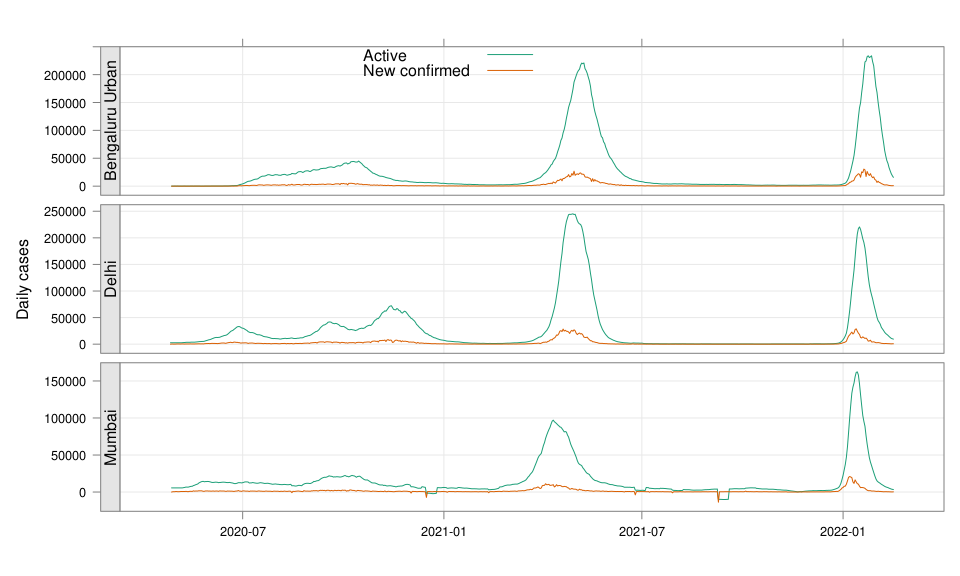 --- 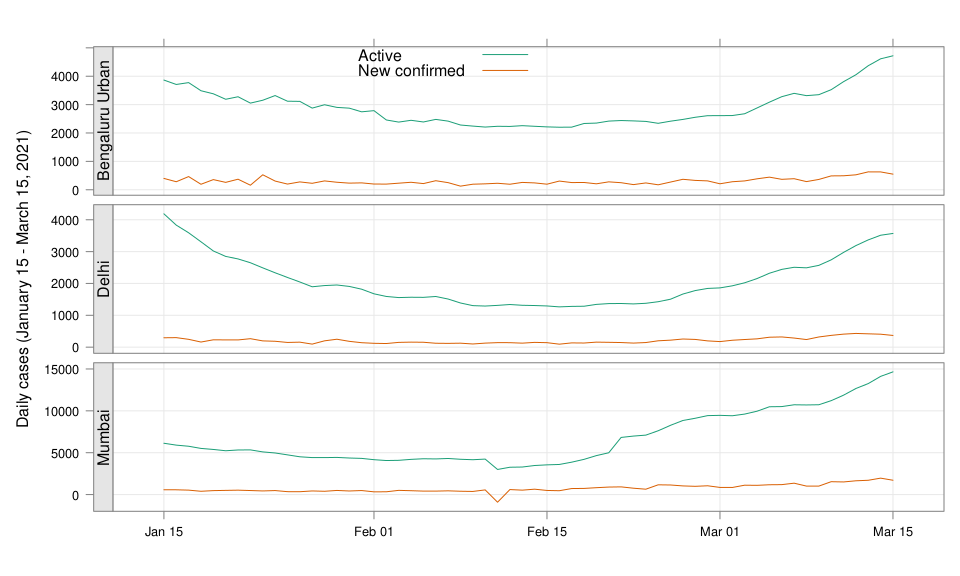 <!-- 2021-04-09 26631 2021-04-15 54309 linc = diff(log(c(26631, 54309))) 91859 - max active - lower by same log exp(log(91859) - linc) # potential gain in max active if lockdown had begun 1 week earlier --> --- # Question - Could we have predicted (on March 15, say) that things are going to get this bad? -- - We now know that INSACOG warned about variants of concern in early March - But underlying data is not publicly available --- # Question (rephrased) - Could we have predicted (on March 15, say) that things are going to get this bad? - ... using only publicly available data (daily new cases, active cases, recoveries, deaths) --- # What should we predict exactly? - How do we quantify prediction? For example: - Is it useful to know the predicted number of cases two weeks from now? - How do we act on such a number? -- - We ended up with the following quantification: .center[ __How long do we have till we hit limits of medical capacitity?__ ] - Here medical capacitity is represented by a critical number of _active_ cases --- class: center middle # Fast-forward: Would we have predicted the current surge? --- 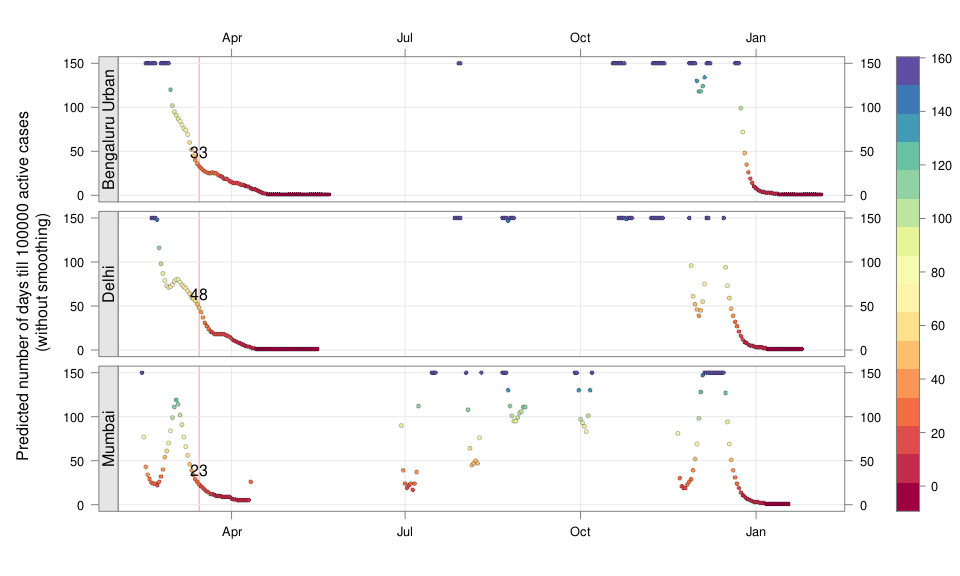 .center[ [Interactive version](#ipred1) ] --- 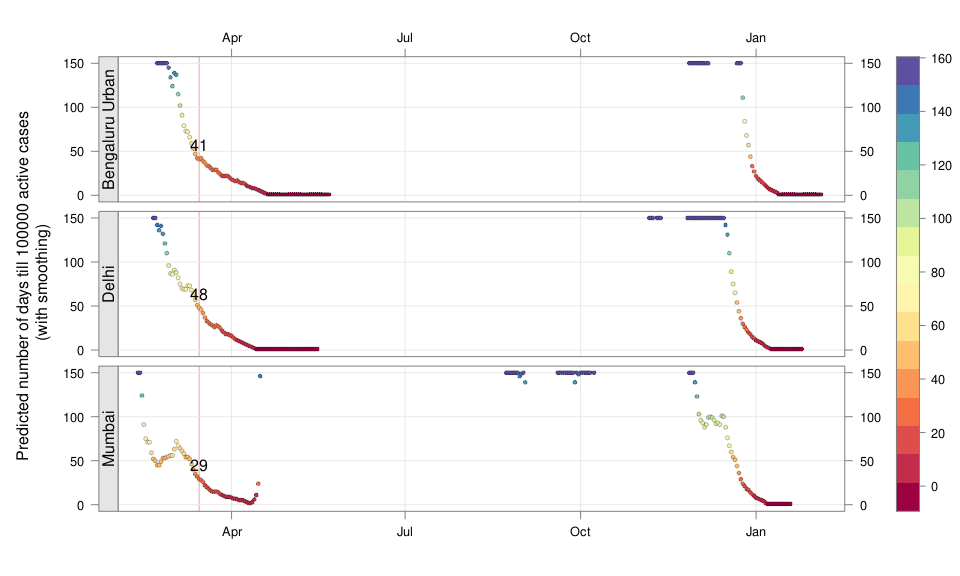 .center[ [Interactive version](#ipred2) ] --- # More results - [Selected Indian Cities](#appendix) - [Selected Indian States](active-prediction-state.html) - [Selected Countries](active-prediction-bycountry.html) - [Kerala](active-prediction-kerala.html) - [Karnataka](active-prediction-karnataka.html) - [West Bengal](active-prediction-wb.html) - [Maharashtra](active-prediction-maharashtra.html) --- class: middle center # How did we arrive at these predictions? --- # Goal * Simple scheme to predict number of active cases * Warning system based on zonewise ability to handle active cases * Input requirements: - Daily number of confirmed / active cases (available from state bulletins) - Critical number of active cases (to be determined policymakers) * Output: - Days to critical __at current rate of growth__ <!-- - Number of active cases may be approximated, if necessary (e.g., assuming 1% death rate, rest recovered 10 days after confirmation) --> --- # Intuition - If new cases exceed recoveries, active count will grow - Key insight: Need to estimate _growth rate_ - Any "positive" growth rate will eventually lead to exponential growth - Even more alarming if growth rate is increasing --- # A crude estimate - $t$ unit of time (in days) - $\confirmed{t}$ is the total number of confirmed cases upto time $t$ - Estimate rate as ratio of new cases today and new cases yesterday: $$ \rincrementhat{t} = \frac{x(t) - x(t-1)}{x(t-1) - x(t-2)} $$ -- - This is actually too noisy to be useful, so use one-week lag instead $$ \rincrementhat{t} = \frac{x(t) - x(t-7)}{x(t-7) - x(t-14)} $$ --- 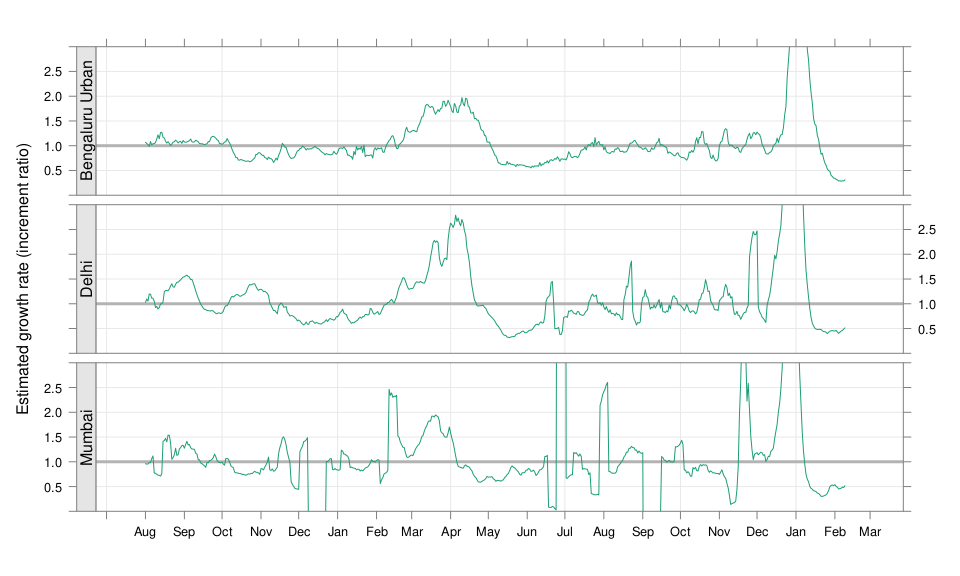 --- 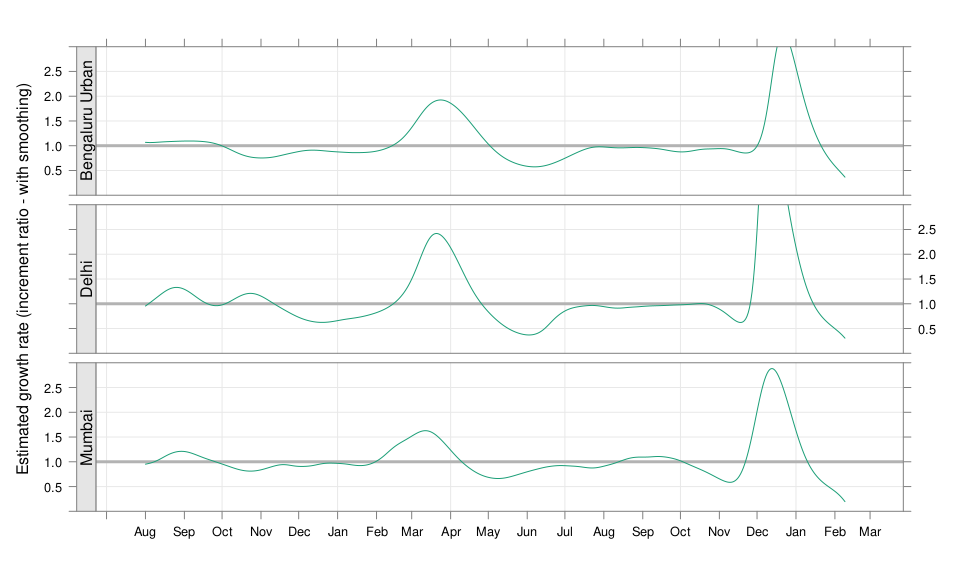 --- # Smoothing - $\rincrementhat{t}$ clearly changes with time - Smoothing can be useful, but _ad hoc_ as no clear criterion -- - We smooth the daily new confirmed case counts $\confirmed{t} - \confirmed{t-1}$ - Take square root first (counts are more like Poisson than Gaussian) - Method: Smoothing spline with effective degrees of freedom set to $n^{1/2}$ - The standard method to select tuning parameter (GCV) _does not_ work well <!-- - GAM (generalized additive model) as implemented in the `mgcv` package in R --> <!-- - Penalized thin-plate spline regression with tuning parameter chosen by GCV --> -- - The results shown are not meant for prediction - For prediction: smoothing should be done only using data available up to prediction date - We also need a more concrete model for reasonable predictions --- layout: true # A more formal model --- - $t$ unit of time (in days) - $\confirmed{t}$ is the total number of confirmed cases upto time $t$ - $\active{t}$ is the total number of active cases at time $t$ -- - $\ractive{t}$ is the _number of new infections per active infection per unit time_ at time $t$ - __Can change with time__ .emph[ (this is a very important point) ] - Depends on many factors: .emph[ virus strain, social behaviour, vaccination ] - Can be influenced by policy: .emph[ restriction on gatherings, lockdown ] -- - $\rinactive{t}$ is the _number of deaths / recoveries per active infection per unit time_ at time $t$ - Assumed constant: $\rinactive{t} \equiv 1/10$ -- - A simple evolution model: $$ \active{t + h} - \active{t} \approx h \cdot \active{t} \cdot [ \ractive{t} - \rinactive{t} ] $$ --- - This gives an instantaneous definition of $\ractive{t}$ as $$ \ractive{t} = \rinactive{t} + \frac{\dactive{t}}{\active{t}} $$ - For discrete-time data, we can estimate $\ractive{t}$ by $$ \ractivehat{t} = \rinactive{t} + \frac{ \active{t + h} - \active{t} }{ h \cdot \active{t} } $$ - Smallest possible $h = 1$, but we use $h = 7$ to reduce day-of-the-week patterns — or smooth $\active{t}$ -- - Simpler than standard SIR models: - Ignores changes in subpopulation fractions (infected, recovered, susceptible) - These variations are subsumed in time-varying $\ractive{t}$ - The goal is to _warn_ when cases are _low_ (not to model full course) <!-- - Alternative model 1: $$ \confirmed{t + h} - \confirmed{t} \approx h \cdot \active{t} \cdot \rconfirmed{t} $$ - Estimate: $$ \rconfirmed{t} = \frac{ \confirmed{t + h} - \confirmed{t} }{ h \cdot \active{t} } $$ - Alternative model 2 (direct estimate from definition): $$ \frac{\confirmed{t + h} - \confirmed{t}}{\confirmed{t} - \confirmed{t-h}} \approx h \cdot \active{t} \cdot \rincrement{t} $$ - It turns out that $\ractive{t}$ and $\rincrement{t}$ behave similarly, $\rconfirmed{t}$ is a bit different --> --- layout: false 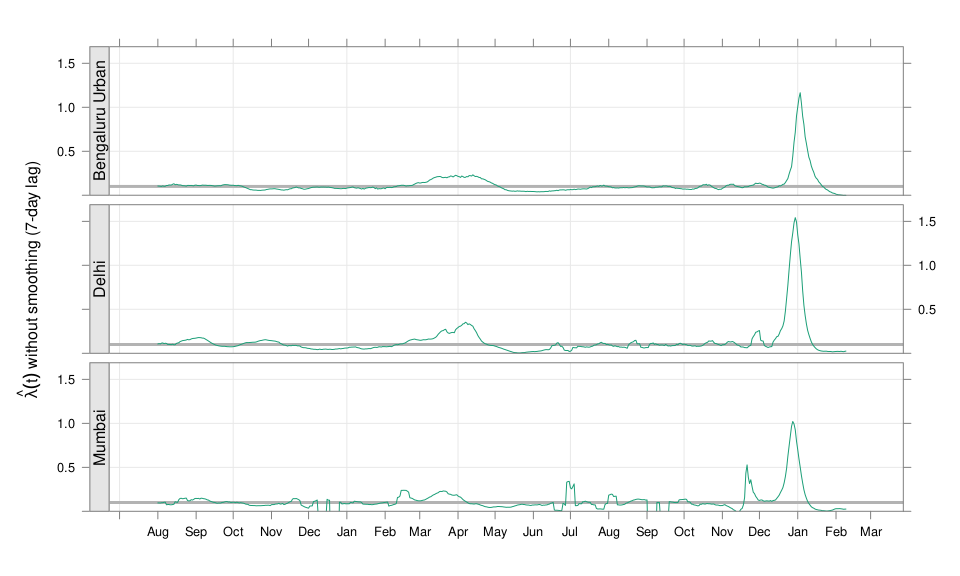 --- 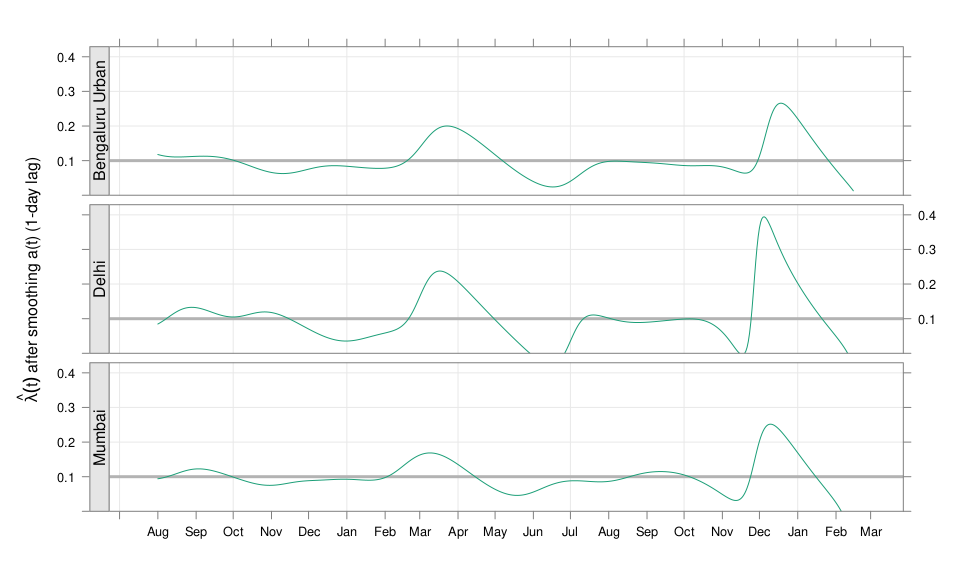 --- # Key observations - $\ractive{t}$ is __not__ constant - Shows periodic stretches of growth and decline - No systematic pattern - Likely combination of biological (variants / vaccination) and social (behaviour) factors - Difficult to predict --- layout: true # Making predictions --- - Prediction equations: <div> \begin{eqnarray*} \active{s} &=& \active{s-h} + h \cdot \active{s-h} \, [ \ractivehat{s-h} - \rinactive{s-h} ] \\ &=& \active{s-h} \left( 1 + h \cdot [ \ractivehat{s-h} - \rinactive{s-h} ] \right) \end{eqnarray*} </div> - Can take $h = 1$ for prediction $$ \active{s+1} = \active{s} \left( 1 + \ractivehat{s} - \rinactive{s} \right) $$ - Question: How to estimate $\ractive{s}$ for future time $s$? --- layout: false # Predicting $\ractive{s}$ for future time $s$ - Prediction can be meaningful only for short ranges - We estimate $\ractive{s-h}$ as a linear function of $h$: - Start from the last calculated value on date of prediction - Linear slope estimated from the last two changes - For robustness, we take average over last few values - Start from average of last 4 calculated values of $\ractive{t}$ on date of prediction - Linear slope estimated using linear regression of last 5 estimates -- - Note that - $\ractive{s} > 0.1$ implies active cases will _increase_ over time - $\ractive{s} < 0.1$ implies active cases will _decrease_ over time <!-- - Justification: False alarm better than no alarm --> <!-- - Other models can similarly predict $\active{t}$ - But this seems most stable (TODO: re-check implementations), so only one reported here --> --- layout: true # Example: How soon would this have predicted the Delhi wave? --- 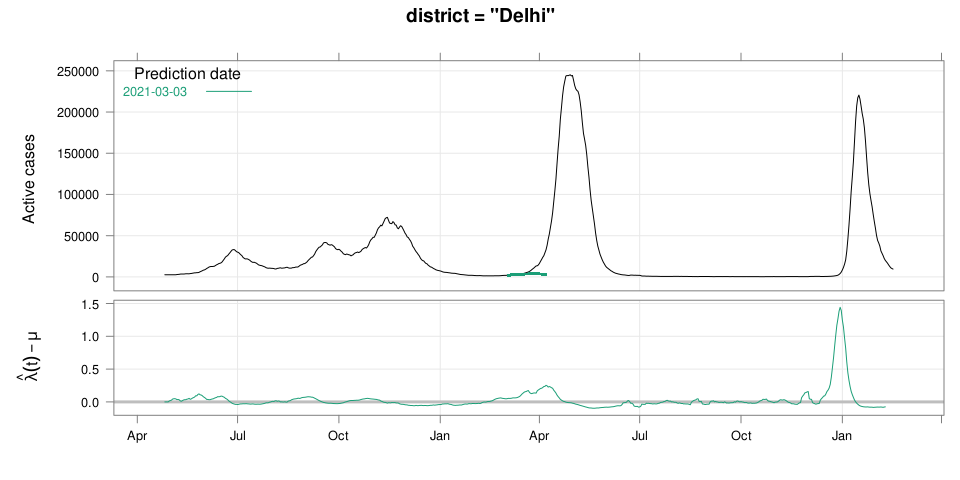 --- 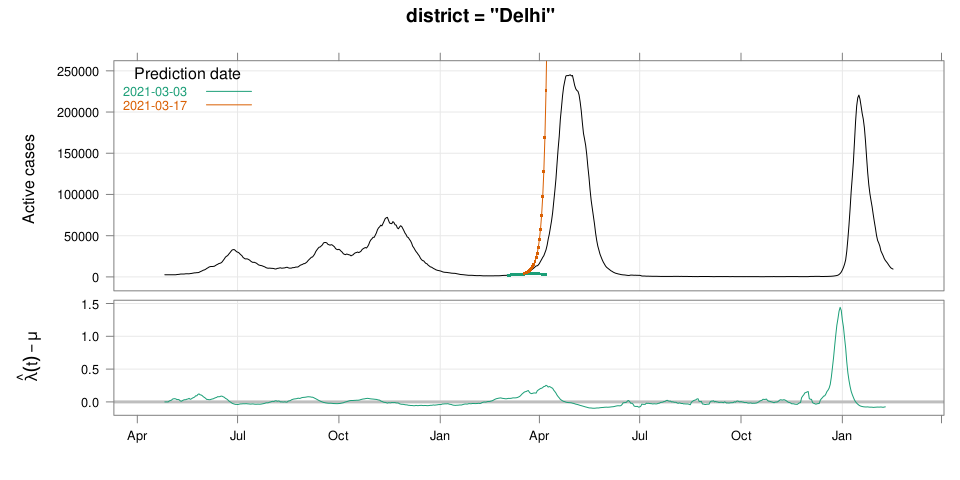 --- 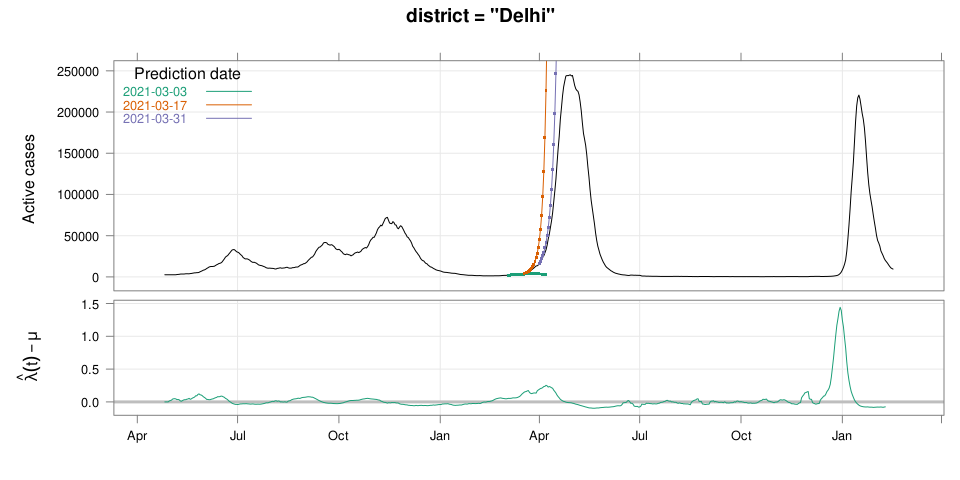 --- 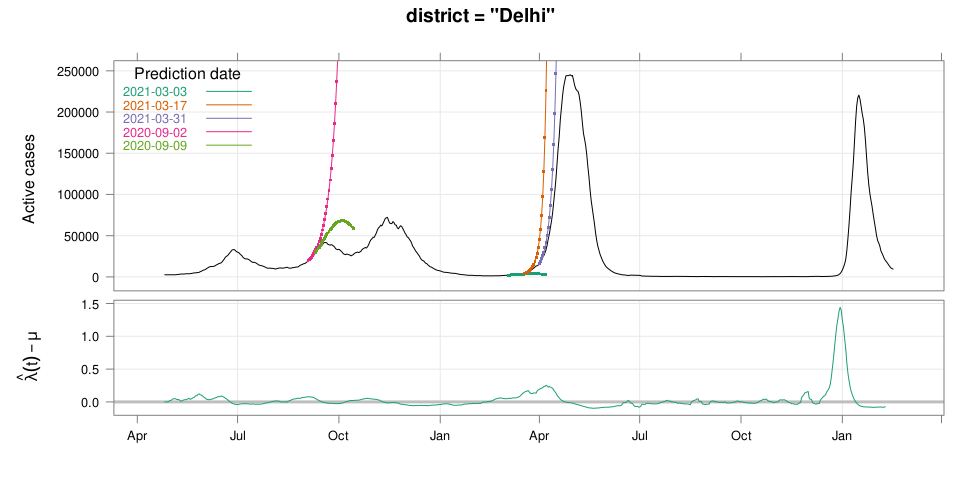 --- - Predictions can change dramatically over the course of a few days - Long-range predictions should _not_ be taken too seriously (linear growth unrealistic) - More important to track $\ractive{t}$ - However, local trends in $\ractive{t}$ __can__ give early warning - Can indicate upcoming surge - Can detect upcoming peaks (inflection points) - Trends easier to spot than from plot of raw active counts <!-- - Should be considered an exploratory summary measure to guide policy / behaviour --> --- layout: true # Early warning: days till _critical load_ --- - A more useful daily summary: number of days to reach critical target - Needs more information: zonewise medical capacity - We will just use target = 100000 - Number of days is capped at 150 (larger values are plotted as 150) --- 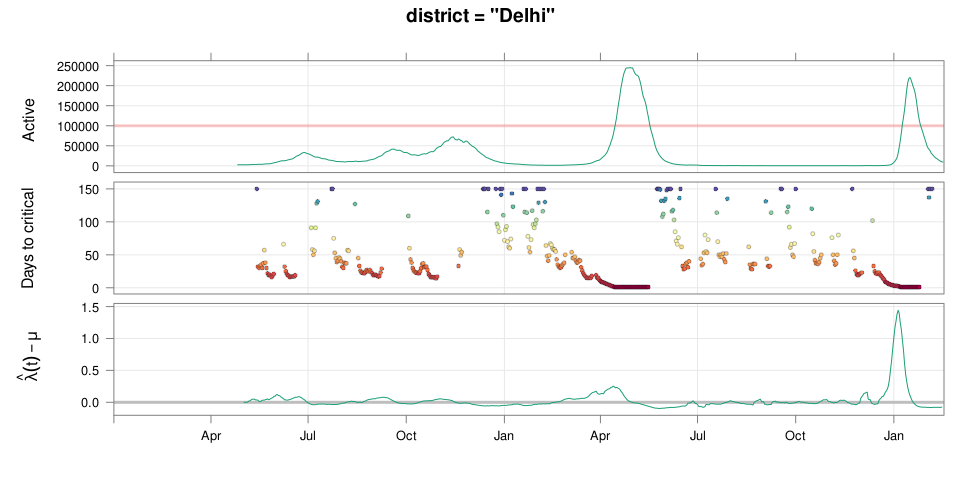 --- - Gives early warning, but also .emph[ lots of false positives ] - Alternative: Assume that $\ractive{s}$ remains .emph[ constant ] in the short run - More conservative predictions, less false alarms --- layout: true # Conservative prediction using constant $\ractive{t}$ --- 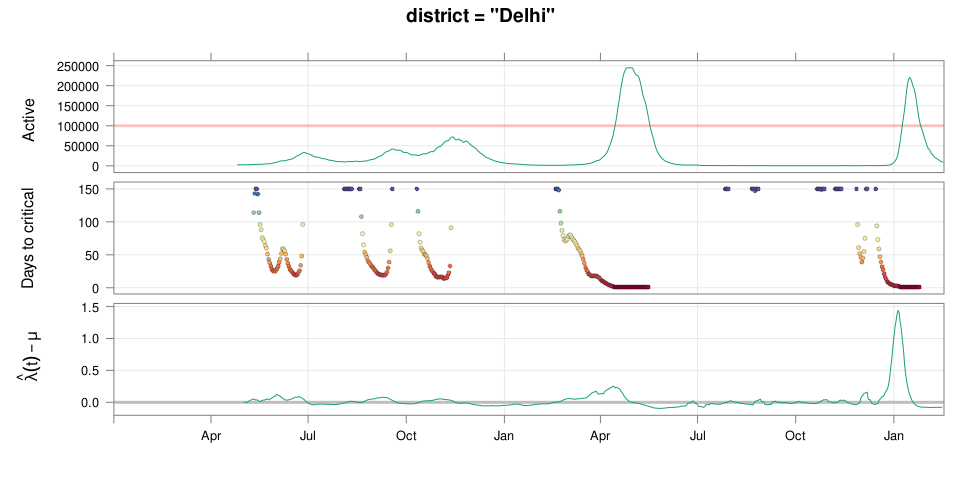 --- layout: true # Does smoothing help? (without looking ahead) --- 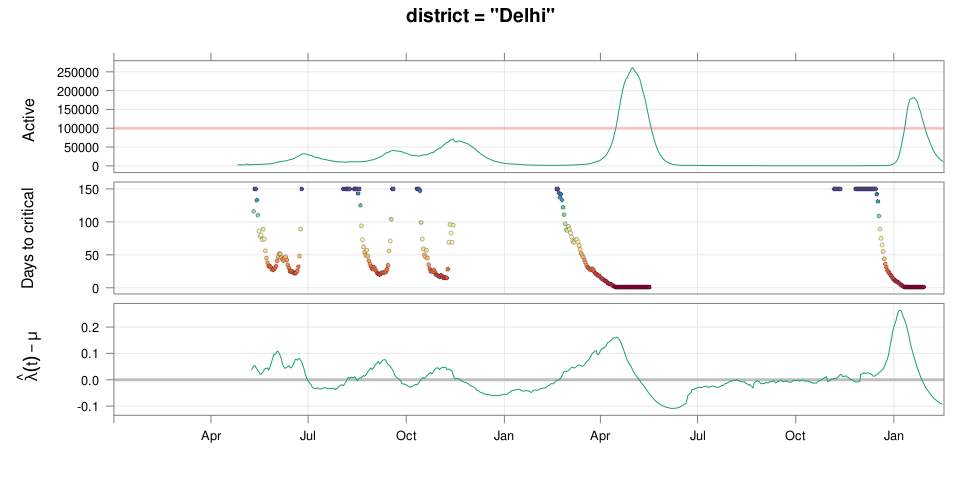 --- layout: false 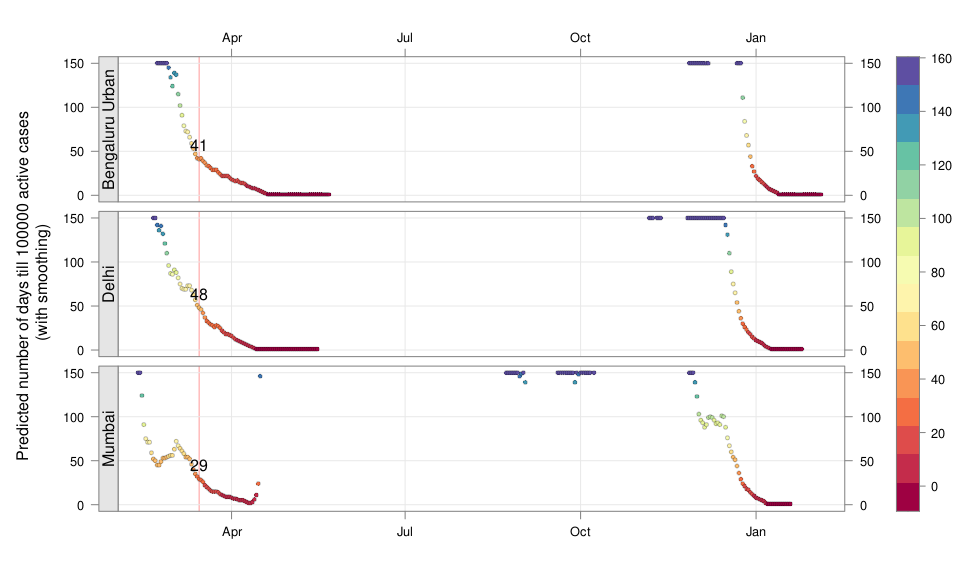 --- # Summary: Prepare for the next surge * Current data can predict time to resource scarcity * Estimates are only approximate, but good enough for early warning * Can be used to guide poilcy: - Graded response can strike balance between normal life and adverse health outcomes - Prevent unnecessary economic slowdown (due to restrictions) - Prevent avoidable deaths (due to lack of basic medical facilities) * Obvious strategies: vaccinate, ramp up healthcare facilities * But need to be prepared for surge (new mutations, loss of immunity, unknown factors) * Late reaction leaves lockdown as only solution, cannot prevent deaths -- * .emph[ Recommendation: ] Automatic restrictions based on current growth rate --- # Other possible uses - Short-term predictions (e.g., [Delhi](Delhi.pdf), [Karnataka](Karnataka.pdf)) - Retrospective study of growth timeline (e.g., [compare urban / rural spread](https://deepayan.github.io/covid-19/increment-ratio.html#11)) - Extend more sophisticated models (e.g. SUTRA) - Key insight: parameters must be estimated _adaptively_ - Smoothing may help --- class: center, middle layout: false name: appendix # Appendix: Predictions in selected Indian cities ("critical" load based on past history) --- 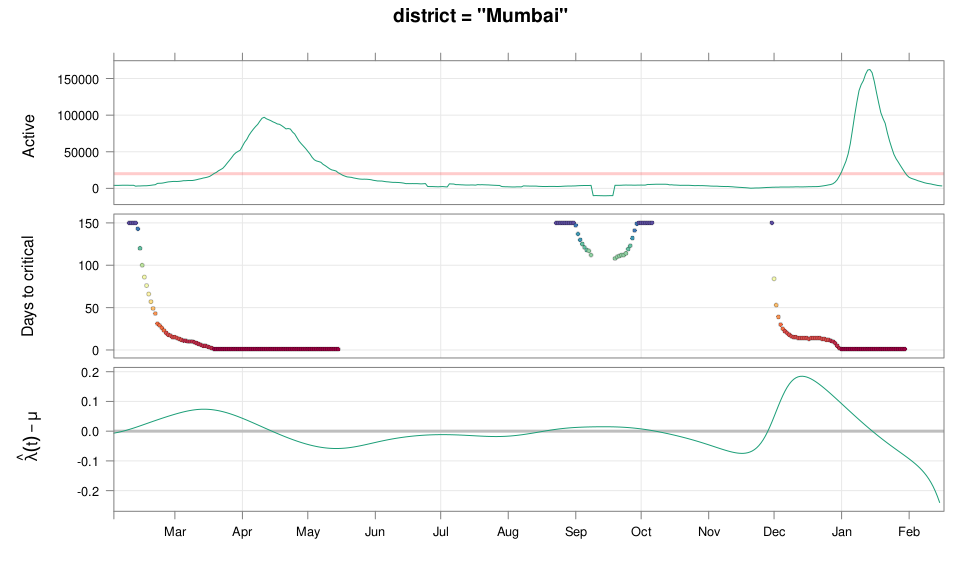 --- 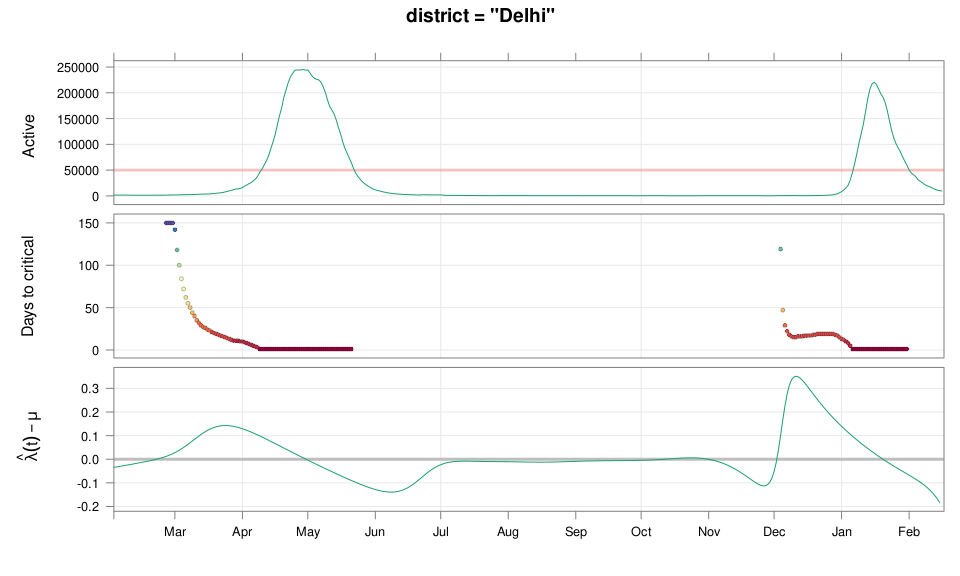 --- 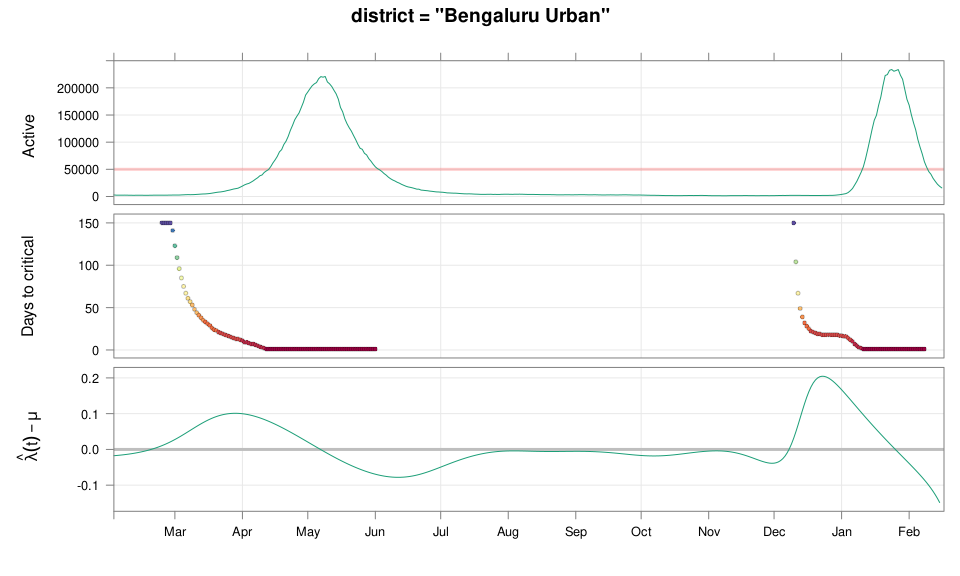 --- 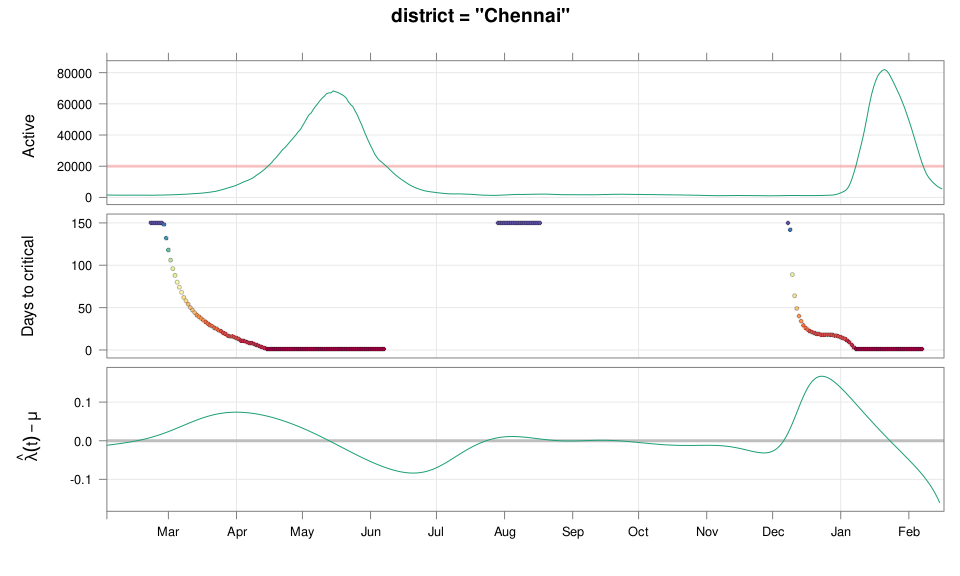 --- 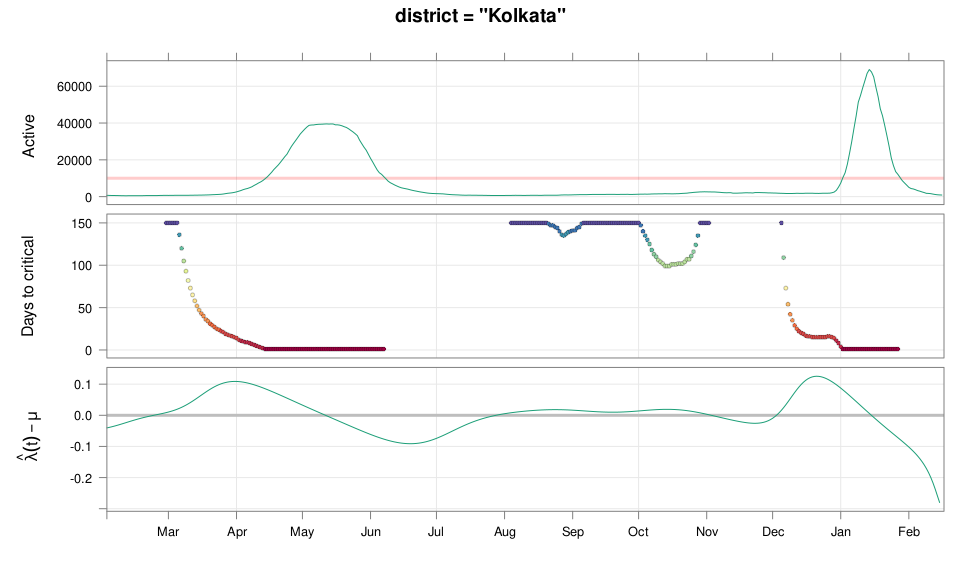 --- 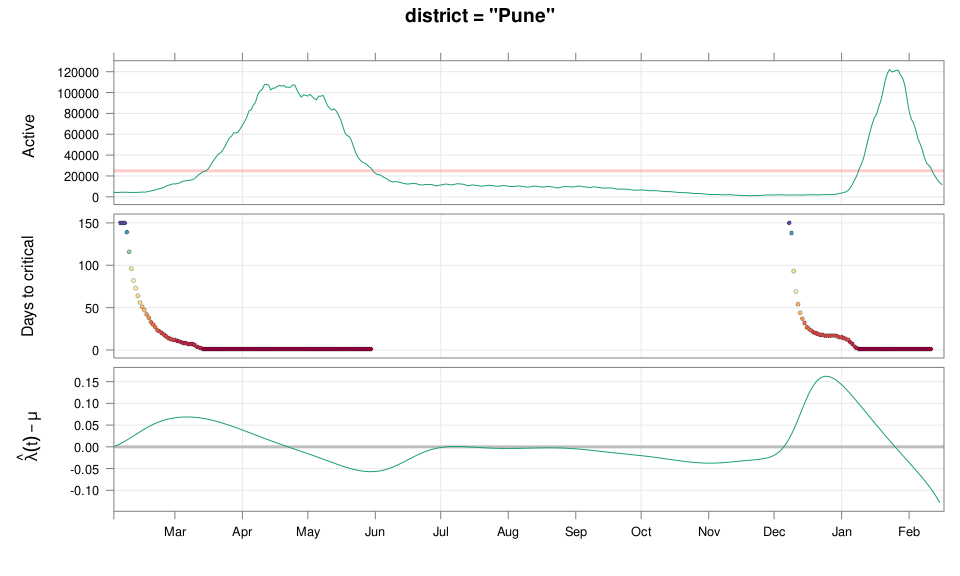 --- name: ipred1 <iframe src="plotly-cp1.html" height="600px" width="99%" style="border: 0px;"></iframe> --- name: ipred2 <iframe src="plotly-cp2.html" height="600px" width="99%" style="border: 0px;"></iframe>